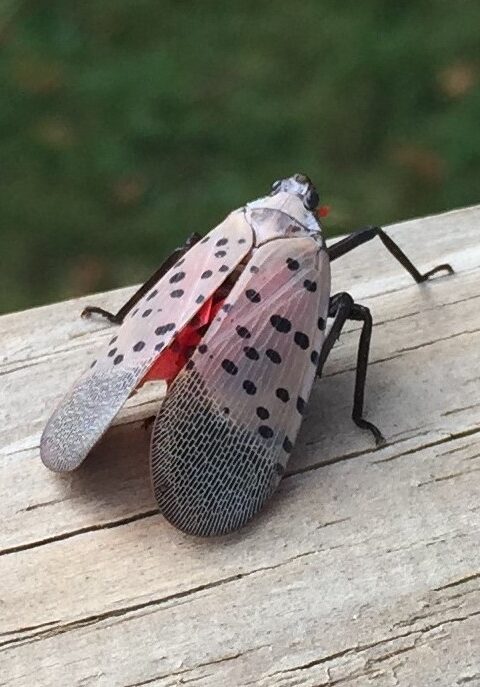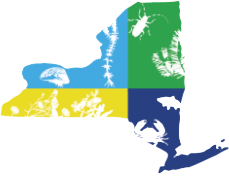Spotted Lanternfly Found on Staten Island, NY
The invasive insect from Asia that had previously established in Pennsylvania and New Jersey has crossed the New York border– threatening agriculture and ecological health. Here’s what state agency officials are announcing:
The New York State Departments of Agriculture and Markets (AGM), Environmental Conservation (DEC), and Office of Parks, Recreation and Historic Preservation (OPRHP) today confirmed that Spotted Lanternfly (SLF), an invasive pest from Asia, has been found on Staten Island. Several live, adult insects were discovered by OPRHP staff in Clay Pit Ponds State Park Preserve. SLF (see photo below) is a destructive pest that feeds on more than 70 plant species, including tree-of-heaven, and plants and crops that are critical to New York’s agricultural economy, such as maple trees, apple trees, grapevine, and hops.

The Department is working closely with its partners at the Department of Environmental Conservation, the State Office of Parks, Recreation and Historic Preservation, and the U.S. Department of Agriculture (USDA) to mitigate the impacts of this destructive pest, which can weaken plants and have a devastating impact on agriculture. While this find on Staten Island is concerning, New York State has taken strong actions to combat the establishment of SLF since 2017. We will continue our work to survey and inspect high-risk areas and implement targeted management plans. We also urge the public to be vigilant and report any suspected sightings of SLF to help slow the spread of this invasive. – State Agriculture Commissioner Richard A. Ball
Since Spotted Lanternfly was first discovered in neighboring states, DEC has worked aggressively with the State Department of Agriculture and Markets, Office of Parks, Recreation and Historic Preservation, USDA and other partners to educate New Yorkers and take steps to prevent this invasive species from establishing itself in New York State. This invasive pest has the potential to severely impact and stress New York’s forests, agricultural crops, and tourism industries. The first live find on Staten Island is concerning, but our goal remains to find Spotted Lanternfly early and prevent it from further entering New York State and limiting any serious threats to our natural resources. – DEC Commissioner Basil Seggos
Spotted Lanternfly poses a troubling threat to the environment and agriculture of New York State but also to the quality of recreational opportunities and experiences we offer in our State Parks and public lands. I applaud our Parks’ environmental stewardship staff for identifying this pest, so New York State can quickly begin taking steps to slow its spread. Park visitors across the state can help in identifying and reporting this destructive pest, and I urge them to familiarize themselves with its signs. – State Parks Commissioner Erik Kulleseid
Following the finding by OPRHP, AGM, working with DEC, OPRHP, and the USDA, immediately began extensive surveys throughout the area. Crews will continue to survey areas on Staten Island, develop management plans to slow SLF’s spread, and minimize the damage and impact from this invasive species. AGM urges New Yorkers to report potential sightings using the web reporting tool found here: https://survey123.arcgis.com/share/a08d60f6522043f5bd04229e00acdd63
SLF feedings can stress plants, making them vulnerable to disease and attacks from other insects. SLF also excretes large amounts of sticky “honeydew,” which attracts sooty molds that interfere with plant photosynthesis, negatively affecting the growth and fruit yield of plants, and impacting forest health. SLF also has the potential to significantly hinder quality of life and recreational activities due to the honeydew and the swarms of insects it attracts.
First discovered in Pennsylvania in 2014, SLF has since been found in New Jersey, Maryland, Delaware, West Virginia and Virginia. Given the proximity to the Pennsylvania and New Jersey infestations, New York State is at high risk for infestation.
Since 2017, AGM, DEC, and OPRHP have taken an aggressive approach to keeping SLF from establishing in New York State, conducting surveys of high-risk areas across the State; inspecting nursery stock, stone shipments, and commercial transports from quarantine areas; and launching a comprehensive education and outreach campaign to enlist the public’s help in reporting SLF.
While these insects can jump and fly short distances, they spread primarily through human activity. SLF can lay their eggs on any number of surfaces, such as vehicles, stone, rusty metal, outdoor furniture, and firewood. Adult SLF can hitch rides in vehicles, on any outdoor item, or cling to clothing or hats, and be easily transported into and throughout New York.
The public is encouraged to thoroughly inspect vehicles, luggage and gear, and all outdoor items for egg masses and adult SLF before leaving areas with SLF, particularly in the counties of states in the quarantine area—Pennsylvania, New Jersey, Maryland, Delaware, West Virginia and Virginia. If SLF adults are found, residents should remove them and scrape off all egg masses.
Residents can also help by allowing surveyors access to properties where SLF may be present. Surveyors will be uniformed and will always provide identification.
Adult SLF are active from July to December. They are approximately one-inch long and half an inch wide at rest, with eye-catching wings. Adults begin laying eggs in September. Signs of an SLF infestation may include:
- Sap oozing or weeping from open wounds on tree trunks, which appear wet and give off fermented odors.
- One-inch-long egg masses that are brownish-gray, waxy and mud-like when new. Old egg masses are brown and scaly.
- Massive honeydew build-up under plants, sometimes with black sooty mold developing.
For more information on Spotted Lanternfly, visit https://agriculture.ny.gov/spottedlanternfly.
Image Credit: A side-top view of an adult spotted lanternfly (Lycorma delicatula) on a wooden rail. Early October. Southeastern Pennsylvania, USA. By Walthery.

